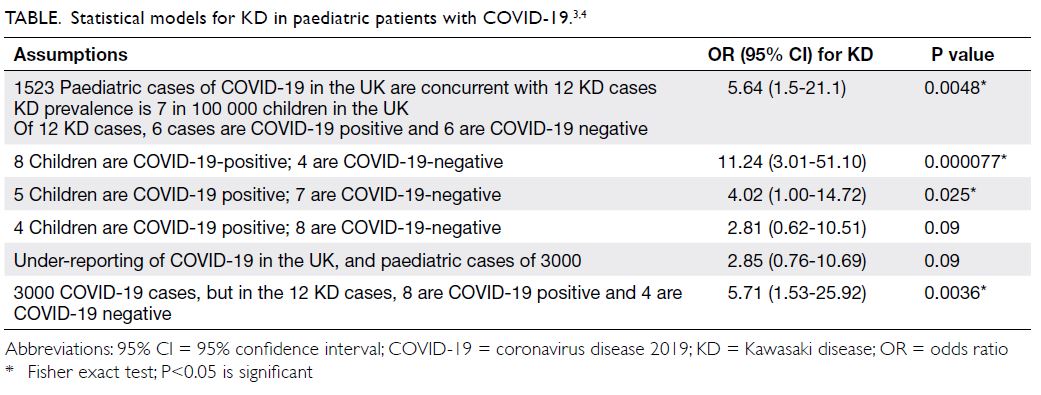Hong Kong Med J 2021 Apr;27(2):161–2 | Epub 9 Apr 2021
© Hong Kong Academy of Medicine. CC BY-NC-ND 4.0
LETTER TO THE EDITOR
Paediatric multisystem inflammatory syndrome
and COVID-19: another novel syndrome?
Karen KY Leung, MB, BS, MRCPCH1; KL Hon, MB, BS, MD1; Maggie HT Wang, BSc, PhD2; Daniel KK Ng, MB, BS, MD3; Patrick Ip, MPH, FRCPCH (UK)1
1 Department of Paediatrics and Adolescent Medicine, Hong Kong Children’s Hospital, Hong Kong
2 JC School of Public Health and Primary Care, The Chinese University of Hong Kong, Hong Kong
3 Department of Paediatrics, Hong Kong Sanatorium & Hospital, Hong Kong
Corresponding author: Dr KL Hon (ehon@hotmail.com)
To the Editor—Children and infants initially
appeared to be largely spared from the coronavirus
disease 2019 (COVID-19) pandemic. However, the
United Kingdom and United States have recently
reported an apparent rise in the number of children
presenting with multisystem inflammatory disease,
some of whom also tested positive for COVID-19.1
A multisystem inflammatory syndrome in
children potentially associated with COVID-19
has been reported, with the following suggested
definition: persistent fever, inflammation, evidence
of single or multi-organ dysfunction; may fulfil full
or partial criteria for Kawasaki disease; severe acute
respiratory syndrome coronavirus 2 (SARS-CoV-2)
polymerase chain reaction testing maybe positive or
negative and other microbial causes excluded.2
About 50% of these patients have no
microbiological evidence of COVID-19 infection,
which fits into one of the hypothetical scenarios
in our epidemiological analysis based on early
data from the United Kingdom, suggesting a
statistically significant correlation between
COVID-19 and Kawasaki disease (P=0.0048)
[Table].3 4 The pathophysiology of COVID-19
is likely to be a hyperinflammatory process of a
massive cytokine storm; however, this clinical
presentation can also be vasculitic in nature as there
is evidence of SARS-CoV leading to vasculitis.4 5 This
apparent link could also be due to the similarities in
clinical presentation between COVID-19 and other
sepsis syndromes including systemic inflammatory
response syndrome, severe acute respiratory
syndrome, toxic shock syndrome, Kawasaki disease shock syndrome, and multi-organ dysfunction syndrome.
Although this phenomenon is reported in
Western countries, the majority of cases are non-Caucasians.6 As the incidence of Kawasaki disease
is up to 10 times higher in Asian than in Western
populations, it is inconceivable that this phenomenon
could only be observed in Western countries,
unless there is an underlying genetic, environment
predisposition, presentation of a new variant of the
SARS-CoV-2 virus, or misinterpretation of data.3
We postulate that SARS-CoV-2 may just
happen to be one of the many respiratory viruses that
can cause a multisystem inflammatory syndrome in
children. The ‘novel phenomenon’ is in fact septic or
toxic shock syndrome associated with viral triggered
inflammation, potentially attributed to a new variant
of SARS-CoV-2. However, we shall remain sceptical
before any definitive conclusions can be drawn. Meanwhile, we caution the loose coining
of too many confusing abbreviations or syndromes
associated with SARS-CoV diseases, such as
SARS, MERS (Middle East respiratory syndrome),
COVID-19, MIS-C (multisystem inflammatory
syndrome in children), PIMS/PIMS-TS (paediatric
inflammatory multisystem syndrome), COVID toe
syndrome, and COVID skin syndrome.7
Author contributions
All authors contributed to the drafting of the letter and critical revision for important intellectual content. All
authors approved the final version for publication and take
responsibility for its accuracy and integrity.
Conflicts of interest
As the editor of the journal, KL Hon was not involved in the peer review process. Other authors have disclosed no conflicts
of interest.
Funding/support
This letter received no specific grant from any funding agency in the public, commercial, or not-for-profit sectors.
References
1. Paediatric Intensive Care Society. PICS Statement:
Increased number of reported cases of novel presentation
of multi system inflammatory disease. 2020. Available from:
https://picsociety.uk/wp-content/uploads/2020/04/PICS-statement-re-novel-KD-C19-presentation-v2-27042020. pdf. Accessed 30 Apr 2020.
2. Royal College of Paediatrics and Child Health. Guidance:
Paediatric multisystem inflammatory syndrome temporally
associated with COVID-19. Available from: https://www.rcpch.ac.uk/sites/default/files/2020-05/COVID-19-Paediatric-multisystem- inflammatory syndrome-20200501.pdf. Accessed 14 May 2020.
3. Campbell D, Sample I. At least 12 UK children have
needed intensive care due to illness linked to Covid-19.
The Guardian [newspaper on the internet]. 27 Apr 2020:
Health. Available from: https://www.theguardian.com/world/2020/apr/27/nhs-warns-of-rise-in-children-with-new-
illness-that-may-be-linked-to-coronavirus. Accessed 30 Apr 2020.
4. Riphagen S, Gomez X, Gonzalez-Martinez C, Wilkinson N, Theocharis P. Hyperinflammatory shock in children during
COVID-19 pandemic. Lancet 2020;395:1607-8. Crossref
5. Ding Y, Wang H, Shen H, et al. The clinical pathology of
severe acute respiratory syndrome (SARS): A report from
China. J Pathol 2003;200:282-9. Crossref
6. Public Health England. The weekly surveillance report
in England (Week 16 April 2020 to 22 April 2020).
Available from: https://assets.publishing.service.gov.uk/government/uploads/system/uploads/attachment_data/file/880848/COVID19_Weekly_Report_22_April.pdf.
Accessed 28 Apr 2020.
7. Hon KL, Leung AK, Wong JC. Proliferation of syndromes
and acronyms in paediatric critical care: are we more or
less confused? Hong Kong Med J 2020;26:260-2.Crossref


